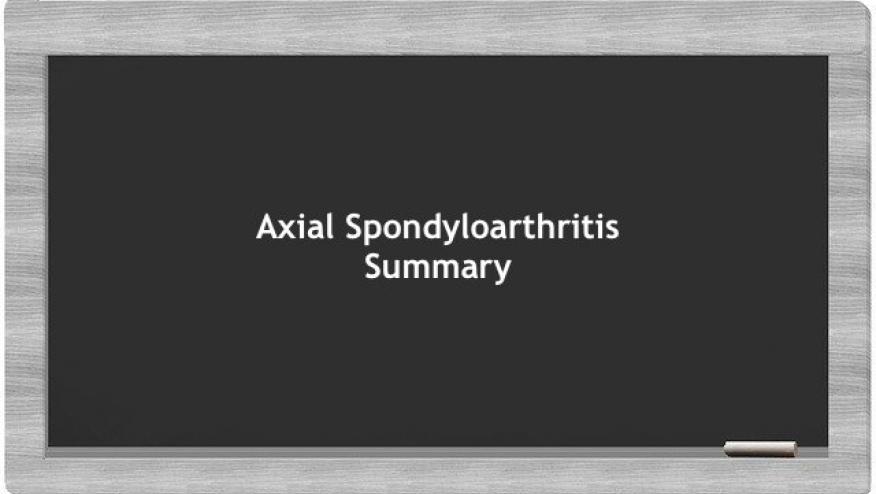Update on Axial SpA at EULAR 2022 Save

This year at EULAR 2022, there were important and interesting topics in Axial Spondyloarthritis (AxSpA). These are my picks of abstracts from the conference.
Non-steroidal anti-inflammatory drugs (NSAIDs) are standard treatments used in the management of AxSpA. What is its efficacy when used in combination with biologics? In OP0018 by Proft et al, the CONSUL study showed there was no significant difference in Celecoxib(CEL)+ Golimumab (GOL) vs GOL alone. The mSASSS change was 1.1 vs 1.7, p=0.79 between the 2 groups. The combination may be clinically relevant in high-risk progressors.
On the topic of radiographic progression in AxSpA, the PROOF study presented by by Poddubnyy et al in OP0149 showed the predictors of radiographic progression included male gender, good response to NSAIDs, fulfillment of the imaging arm and being HLA-B27+. The rate of progression from non-radiographic AxSpA to radiographic AxSpA was also presented. The PROOF study showed that 16% of nr-AxSpA pts progressed to r-AxSpA within 5 years, mean time to radiographic progression was 2.4 years.
In the area of new therapies, upadacitinib (UPA), a JAK inhibitor, has been used in the treatment of radiographic AxSpA or ankylosing spondylitis. What is its efficacy when used in non-radiographic AxSpA? In OP0016 by van den Bosch, the use of Upadacitinib in patients with active non-radiographic AxSpA from a Phase 3 RCT SELECT-AXIS 2 was presented. The ASAS40 response rate for UPA was twice vs placebo (45% vs 23%). 12/14 of the secondary endpoints were also met. In the area of biologic inadequate response in AS, UPA 15 mg od was significantly more effective than placebo over 14 weeks with ASAS40 UPA 45% vs PBO 18% and the onset of effect seen by week 4. No new safety risks identified in the SELECT-AXIS 2 study by Van de Heijde et al POS0306.
Gender differences in terms of response to biologics in AxSpA is another topic that has gained increased attention in the last few years. I remember listening to this topic back in 2018 at the ASAS Gent Spondyloarthritis meeting. So much work has taken place leading to a better understanding of this topic. In OP0020 by Hellamand et al, gender differences in response to first line anti-TNF in AxSpA from fifteen countries in the EuroSpA Research Collaboration Network was presented. Sex differences may affect the response to first line TNFi in AxSpA. Hellamund et al EuroSpA study showed the TNFi 6/12/24 month retention rate was lower in females (58%) compared to males (72%). Females had lower CRP levels and higher PROs at baseline.
The topic of peripheral spondyloarthritis (pSpA) is also further discussed at the conference. POS0148 by Granados et al, looks at the different outcome measures such as SPARCC, MASES, LEI and MEI on enthesitis in PerSpA as well as Axial SpA and Psoriatic Arthritis. This study showed a preference for certain outcome measures for specific conditions. For AxSpA, MEI and MASES. For pSpA and PsA, MEI and SPARCC. The LEI may underestimate the prevalence of enthesitis. In this same group of conditions, the determinants of general health (GH) and health related quality of life (QoL) is looked at in POS0147 by Santos et al. In all types of SpA, daily activities and function are major determinants of QoL. For GH, in addition to daily activity and function, sociodemographic factors such as gender and education also play an important role.
In the area of comorbidities in AxSpA, depression has a significant impact. Treatment of active SpA improves depressive symptoms in SpA with Hospital Anxiety and Depression Score (HADS) Depression score reducing. This was greatest for TNFi followed by NSAIDs and csDMARDs. TNFi reduced the proportion of patients (48% to 29%) with depressive symptoms at follow-up by Weber et al in POS0304. This shows how active treatment not only improves joint symptoms but also comorbidities such as depression.
The impact of AxSpA and its treatment in pregnancy is also covered in two abstracts. Hamroun S et al OP0153 for the GR2 Cohort showed that age and use of NSAIDs in the preconception period was associated with a longer time to conception in women with SpA. Research is needed on continuous NSAID use in the preconception period. Pregnancy outcomes in SpA (including PsA) were also presented by Crisafulli et al POS151 with 40% experiencing a flare during pregnancy and 40% postpartum. Flare was common in the 2nd trimester and in patients with axial involvement, some requiring restart of TNFi treatment. Having a flare in pregnancy was not associated with a postpartum flare.
Finally, we all use recommendations and guidelines to help us in our daily clinical practice. This year there was the update of the ASAS/EULAR Recommendations on the management of AxSpA presented by Sofia Ramiro. This was alongside the updates for the EULAR recommendations in rheumatoid arthritis and ANCA-associated vasculitis.
I hope you have enjoyed the coverage of these key topics in Axial SpA from EULAR 2022.
Interested in more AS/Spondyloarthritis news and updates? Visit our topic page here: https://rheumnow.com/topic/ankylosing-spondylitis










If you are a health practitioner, you may Login/Register to comment.
Due to the nature of these comment forums, only health practitioners are allowed to comment at this time.